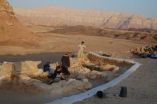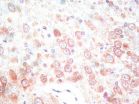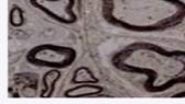(Press-News.org) In 1934, American archaeologist Nelson Glueck named one of the largest known copper production sites of the Levant "Slaves' Hill." This hilltop station, located deep in Israel's Arava Valley, seemed to bear all the marks of an Iron Age slave camp – fiery furnaces, harsh desert conditions, and a massive barrier preventing escape. New evidence uncovered by Tel Aviv University archaeologists, however, overturns this entire narrative.
In the course of ongoing excavations at Timna Valley, Dr. Erez Ben-Yosef and Dr. Lidar Sapir-Hen of TAU's Department of Archaeology and Near Eastern Cultures analyzed remnants of food eaten by copper smelters 3,000 years ago. The result of this analysis, published in the journal Antiquity, indicates that the laborers operating the furnaces were in fact skilled craftsmen who enjoyed high social status and adulation. They believe their discovery may have ramifications for similar sites across the region.
"What we found represents a general trend or reality related to metal workers in antiquity," said Dr. Ben-Yosef. "They had a very unique role in society, and we can demonstrate this by looking at Timna."
Examining ancient leftovers
The rare arid conditions of Timna have resulted in unparalleled preservation of organic materials usually destroyed by the march of time: bones, seeds, fruits, and even fabric dating back to the 10th century B.C.E. Using a technique called "wet sieving," the archaeologists found miniscule animal and fish bones, evidence of a rich and diverse diet.
"The copper smelters were given the better cuts of meat – the meatiest parts of the animals," said Dr. Sapir-Hen. "Someone took great care to give the people working in the furnaces the best of everything. They also enjoyed fish, which must have been brought from the Mediterranean hundreds of kilometers away. This was not the diet of slaves but of highly-regarded, maybe even worshipped, craftsmen."
Copper, used at the time to produce tools and weapons, was the most valuable resource in ancient societies. According to Dr. Ben-Yosef, the smelters needed to be well-versed in the sophisticated technology required to turn stone into usable copper. This knowledge was so advanced for the time it may have been considered magical or supernatural.
"Like oil today, copper was a source of great power," said Dr. Ben-Yosef. "If a person had the exceptional knowledge to 'create copper,' it is not surprising he would have been treated well. In comparing our findings to current ethnographic accounts from Africa, we see smelters worshipped and even honored with animal sacrifices."
Copper production is a complex operation requiring many levels of expertise. Ancient mine workers at Timna may have indeed been slaves or prisoners, because theirs was a simple task performed under severe conditions. However, the act of smelting, turning stone into metal, required an enormous amount of skill and leadership. The smelter had to build a furnace out of clay in precise dimensions, provide the right amount of oxygen and charcoal, maintain a 1,200 degree (Celsius) heat, connect bellow pipes, blow a fixed amount of air, and add an exact mixture of minerals. All told, the smelter had to manage some 30-40 variables in order to produce the coveted copper ingots.
Reconstructing social diversity
According to Dr. Sapir-Hen, an expert on early complex societies, the food remains reflect the social stratification of different laborers at the site. "By studying the remains of domesticated food animals, we reveal differential access to meat that may indicate different levels of specialization among workers at the same site. This allowed us to reconstruct social diversity at the site," said Dr. Sapir-Hen.
The remains of the wall found at the Timna site, once considered a barrier used to contain slave laborers, apparently played a different role as well. "We now know it was a wall used to defend the sophisticated technology and its most precious product – the ingot, the result of the complex copper smelting process," said Dr. Ben-Yosef.
The research on the ancient societies of Timna continues as part of the Central Timna Valley (CTV) Project of Tel Aviv University.
INFORMATION:
American Friends of Tel Aviv University supports Israel's leading, most comprehensive and most sought-after center of higher learning, Tel Aviv University (TAU). Rooted in a pan-disciplinary approach to education, TAU is internationally recognized for the scope and groundbreaking nature of its research and scholarship — attracting world-class faculty and consistently producing cutting-edge work with profound implications for the future. TAU is independently ranked among the world's top universities and #1 in Israel. It joins a handful of elite international universities that rank among the best producers of successful startups.
Ancient metal workers were not slaves but highly regarded craftsmen
Iron Age copper smelters were respected leaders with sophisticated skills, say Tel Aviv University archaeologists
2014-08-28
ELSE PRESS RELEASES FROM THIS DATE:
Global warming pioneer calls for CO2 to be taken from atmosphere and stored underground
2014-08-28
Wally Broeker, the first person to alert the world to Global Warming, has called for atmospheric CO2 to be captured and stored underground. He says that Carbon Capture, combined with limits on fossil fuel emissions, is the best way to avoid global warming getting out of control over the next fifty years. Professor Broeker (Columbia University, New York) made the call during his presentation to the International Carbon Conference in Reykjavik, Iceland, where 150 scientists are meeting to discuss Carbon Capture and Storage.
He was presenting an analysis which showed that ...
Neuroscientists watch imagination happening in the brain
2014-08-28
"You may say I'm a dreamer, but I'm not the only one," sang John Lennon in his 1971 song Imagine.
And thanks to the dreams of a BYU student, we now know more about where and how imagination happens in our brains.
Stefania Ashby and her faculty mentor devised experiments using MRI technology that would help them distinguish pure imagination from related processes like remembering.
"I was thinking a lot about planning for my own future and imagining myself in the future, and I started wondering how memory and imagination work together," Ashby said. "I wondered if they ...
Protected areas proven to protect biodiversity
2014-08-28
Protected areas conserve biodiversity and more action is needed to ensure safeguards are in place to protect these areas, researchers say.
Published in PLOS ONE, researchers from Monash University, Stellenbosch University and the University of Exeter, used meta-analysis - combining results from different studies - to look at the past 30 years of research into these areas, to determine whether they actually protect biodiversity.
Dr Bernard Coetzee, School of Biological Sciences, said protecting an area from human exploitation made common sense, however, up until now ...
Serotonin transporter is a mifepristone pharmacological target
2014-08-28
In the central nervous system, serotonergic transmission is critically regulated by serotonin reuptake through the serotonin transporter. As a crucial pharmacological target of antidepressants, the role of erotonin transporter in treatment of major depression is well-established. Dr. Chaokun Li and co-workers from Xinxiang Medical University in China cloned the human brain serotonin transporter into Xenopus oocytes, to establish an in vitro expression system. Two-electrode voltage clamp recordings were used to detect serotonin transporter activity. Their results show that ...
Vasopressin decreases neuronal apoptosis during cardiopulmonary resuscitation
2014-08-28
Epinephrine has been shown to be a first-choice drug for cardiopulmonary resuscitation. Nevertheless, its β-adrenergic effect probably increases myocardial oxygen consumption and leads to severe cardiac and cerebral injuries; moreover, epinephrine does not elevate long-term survival rates. The American Heart Association and the European Resuscitation Council recently recommended that vasopressin can be used for cardiopulmonary resuscitation, instead of epinephrine. However, the guidelines do not discuss the effects of vasopressin during cerebral resuscitation. According ...
Sciatic nerve repair using adhesive bonding and a modified conduit
2014-08-28
When repairing nerves with adhesives, most researchers place glue directly on the nerve stumps, but this method does not fix the nerve ends well and allows glue to easily invade the nerve ends. Ordinarily, nerve conduits are cylindrical. However, it is difficult to insert the nerve ends into the conduit because the nerve is soft and there is frictional resistance. Xiangdang Liang and co-workers from the General Hospital of Chinese PLA designed a special conduit for the adhesive technique and defined the best parameters for its use through in vitro testing, and then repaired ...
New technique uses fraction of measurements to efficiently find quantum wave functions
2014-08-28
The result of every possible measurement on a quantum system is coded in its wave function, which until recently could be found only by taking many different measurements of a system and estimating a wave function that best fit all those measurements. Just two years ago, with the advent of a technique called direct measurement, scientists discovered they could reliably determine a system's wave function by "weakly" measuring one of its variables (e.g. position) and "strongly" measuring a complementary variable (momentum). Researchers at the University of Rochester have ...
Getting graffiti off a masterpiece (video)
2014-08-28
WASHINGTON, August 28, 2014 — Works of art can take years to create and just seconds to deface. It happened to Mark Rothko's "Black on Maroon" while on display at the Tate Modern gallery in London in 2012. A vandal tagged the painting, landing him two years in jail. Restoration experts teamed up with Dow Chemical to create a cleanser that would get rid of the graffiti and leave the art intact. Learn all about it in this episode of Speaking of Chemistry. The video is available at https://www.youtube.com/watch?v=eGR_AxXdSk0 .
INFORMATION:
Speaking of Chemistry is a production ...
Warm thanks: Gratitude can win you new friends
2014-08-28
Parents have long told their children to mind their Ps and Qs, and remember to say thank you. Now the evidence is in on why it matters.
A UNSW Australia-led study has shown for the first time that thanking a new acquaintance for their help makes them more likely to seek an ongoing social relationship with you.
"Saying thank you provides a valuable signal that you are someone with whom a high quality relationship could be formed," says UNSW psychologist Dr Lisa Williams, who conducted the research with Dr Monica Bartlett of Gonzaga University in the US.
The study, to ...
From nose to knee: Engineered cartilage regenerates joints
2014-08-28
Human articular cartilage defects can be treated with nasal septum cells. Researchers at the University and the University Hospital of Basel report that cells taken from the nasal septum are able to adapt to the environment of the knee joint and can thus repair articular cartilage defects. The nasal cartilage cells' ability to self-renew and adapt to the joint environment is associated with the expression of so-called HOX genes. The scientific journal Science Translational Medicine has published the research results together with the report of the first treated patients. ...
LAST 30 PRESS RELEASES:
Whooping cough vaccination for pregnant women strengthens babies’ immune system
Dramatic decline in new cases of orphanhood in Uganda driven by HIV treatment and prevention programs
Stopping weight loss drugs linked to weight regain and reversal of heart health markers
Higher intake of food preservatives linked to increased cancer risk
Mass General Brigham–developed cholera vaccine completes phase 1 trial
First experimental validation of a “150-year-old chemical common sense” direct visualization of the molecular structural changes in the ultrafast anthracene [4+4] photocycloaddition reaction
Lack of support for people on weight loss drugs leaves them vulnerable to nutritional deficiencies, say experts
Dogs’ dinners can have greater climate impact than owners’
Are you ready to swap salmon for sprats and sardines?
1.6 million UK adults used weight loss drugs in past year
American College of Cardiology comments on new dietary guidelines for Americans
American Society of Gene & Cell Therapy and Orphan Therapeutics Accelerator partner to advance and commercialize promising rare disease treatments
One in 14 patients having day case surgery have new or worse chronic pain 3 months after their operation
New study highlights link between eviction rates and gun violence
Heatwaves heat up soil but not toxin levels in rice, study finds
Digital modeling reveals where construction carbon emissions really come from
Turning farm waste into water filters
New study shows how the spleen helps the immune system accept a transplant
New Mayo Clinic study advances personalized prostate cancer education with an EHR-integrated AI agent
Researchers identify novel therapeutic target to improve recovery after nerve injury
Microbes in breast milk help populate infant gut microbiomes
Reprogramming immunity to rewrite the story of Type 1 diabetes
New tool narrows the search for ideal material structures
Artificial saliva containing sugarcane protein helps protect the teeth of patients with head and neck cancer
Understanding the role of linear ubiquitination in T-tubule biogenesis
Researchers identify urban atmosphere as primary reservoir of microplastics
World’s oldest arrow poison – 60,000-year-old traces reveal early advanced hunting techniques
Bristol scientists discover early sponges were soft
New study uncovers how rice viruses manipulate plant defenses to protect insect vectors
NSF–DOE Vera C. Rubin Observatory spots record-breaking asteroid in pre-survey observations
[Press-News.org] Ancient metal workers were not slaves but highly regarded craftsmenIron Age copper smelters were respected leaders with sophisticated skills, say Tel Aviv University archaeologists




